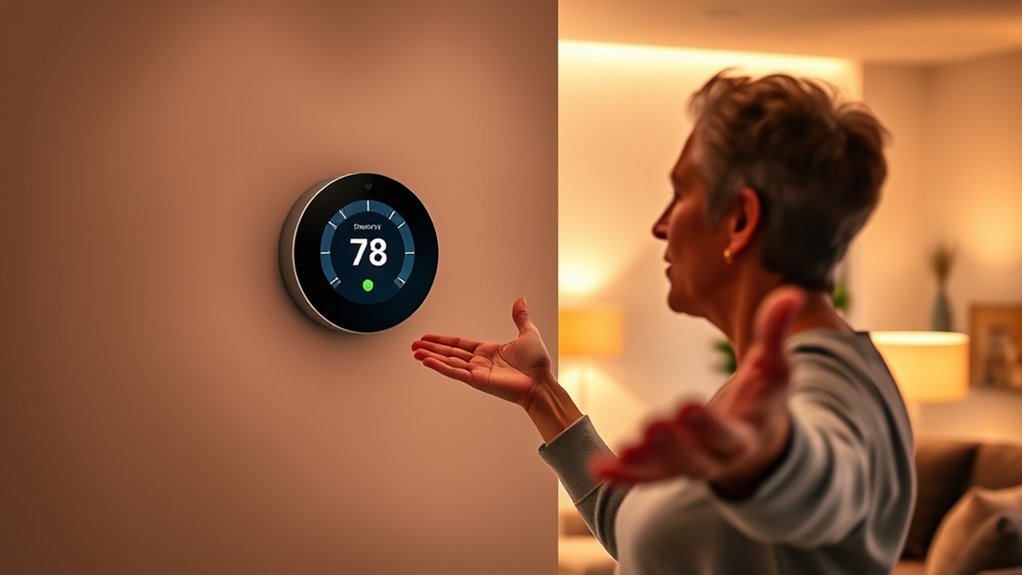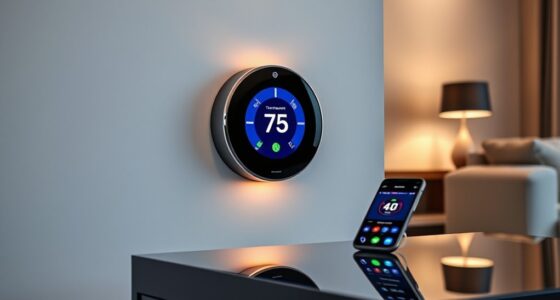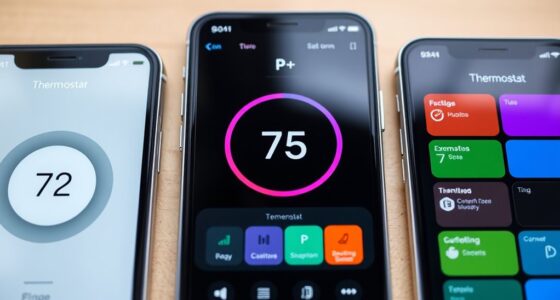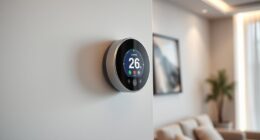To control your smart thermostat with your voice, first make certain you select compatible voice assistant devices and set up your thermostat securely on your Wi-Fi network. Link the devices carefully and customize voice commands for easy control. Troubleshoot connectivity issues by checking your Wi-Fi signal and updating firmware regularly. Proper setup and clear commands improve efficiency and safety. Keep exploring to discover tips for smoother voice control and ideal device performance.
Key Takeaways
- Ensure your thermostat is compatible with your chosen voice assistant by checking manufacturer specifications.
- Connect and securely link your thermostat to the voice assistant following setup instructions.
- Customize voice commands within the app for easy and clear control of temperature adjustments.
- Troubleshoot connectivity issues by checking Wi-Fi, updating firmware, and re-pairing devices as needed.
- Calibrate voice recognition and review privacy settings for optimal performance and data security.
Choosing Compatible Voice Assistant Devices
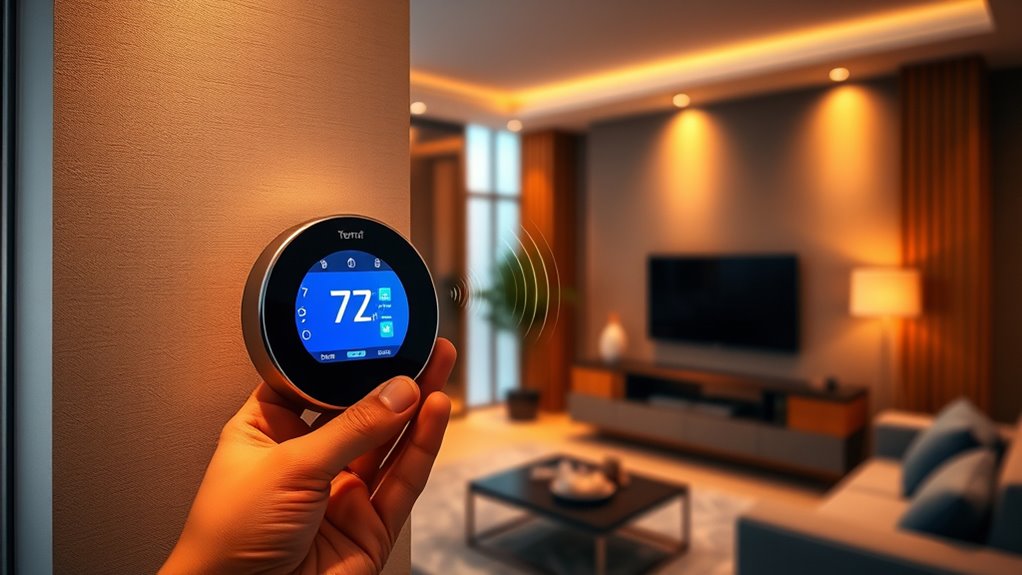
To control your smart thermostat with voice commands, you first need to choose a compatible voice assistant device. Make sure the device you pick works seamlessly with your thermostat model to avoid compatibility issues. Check the manufacturer’s specifications for device compatibility to guarantee smooth operation. While selecting a voice assistant, consider privacy concerns, as these devices often collect data to improve functionality. Opt for devices with strong privacy controls and clear data policies to protect your personal information. Your choice impacts not only convenience but also security. Once you select a compatible device that aligns with your privacy preferences, you’ll be ready to set up voice control and enjoy hands-free temperature management. Additionally, ensuring your smart thermostat has a reliable connection will help maintain consistent performance during voice commands. Being aware of cybersecurity risks associated with connected devices can further safeguard your smart home environment, especially when integrating multiple connected devices into your network.
Setting Up Your Smart Thermostat for Voice Control

After choosing a compatible voice assistant device, the next step is to set up your smart thermostat for voice control. Begin by connecting your thermostat to your Wi-Fi network, ensuring it’s secure to protect your privacy and prevent unauthorized access. Follow the manufacturer’s instructions to enable voice control features, which can help you optimize energy savings by adjusting your home’s temperature efficiently. Be mindful of privacy concerns, and review what data your thermostat shares with your voice assistant. Adjust settings to limit data sharing if needed, ensuring your personal information stays protected. Proper setup allows you to enjoy the convenience of voice commands while maintaining control over your privacy and energy consumption. Additionally, understanding the effectiveness of eye patches can help you optimize your skincare routine for better results. Regular updates and firmware upgrades can improve the security features of your smart home devices, ensuring ongoing protection. This step is essential for seamless, secure voice control of your smart thermostat, allowing you to manage your home environment effortlessly.
Linking Your Thermostat to Your Voice Assistant
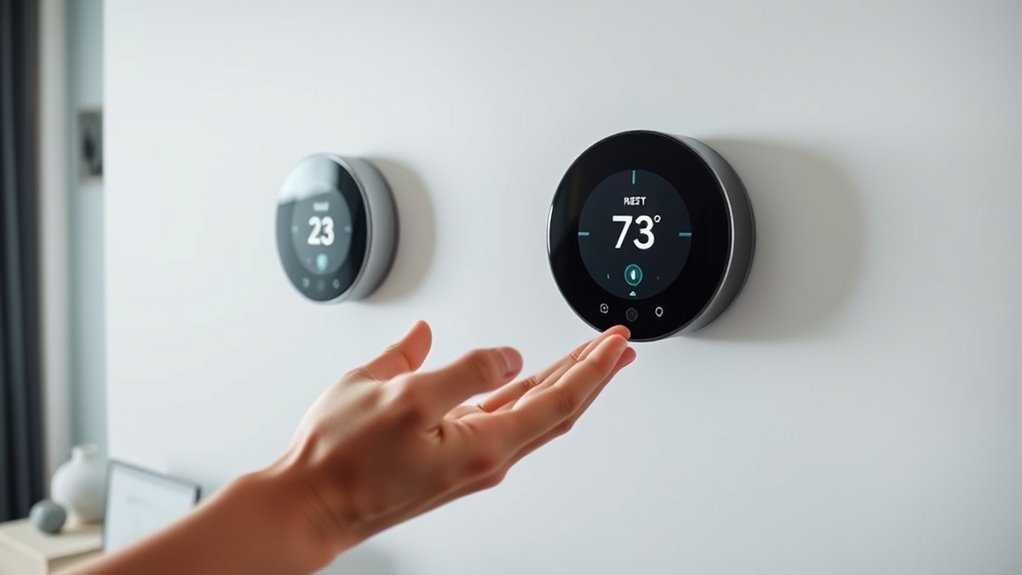
Once you’ve completed the initial setup of your smart thermostat, the next step is to link it to your voice assistant. This connection allows you to control your thermostat hands-free, making daily adjustments more convenient. During the linking process, be mindful of privacy concerns, as some voice assistants collect data to improve functionality. Check the privacy settings and permissions to make certain your information is protected. Linking your thermostat properly can also enhance energy savings by enabling routines and schedules that optimize heating and cooling. A secure connection reduces the risk of unauthorized access, giving you peace of mind. Additionally, reviewing your privacy policy can help you understand how your data is handled during this process. Proper integration with voice assistants can also facilitate smart home automation and improve overall efficiency. When selecting a voice assistant, consider brand compatibility to ensure seamless operation with your specific thermostat model. Once linked, you’ll be able to give voice commands confidently, knowing your device is both efficient and secure.
Configuring Voice Commands for Temperature Adjustments
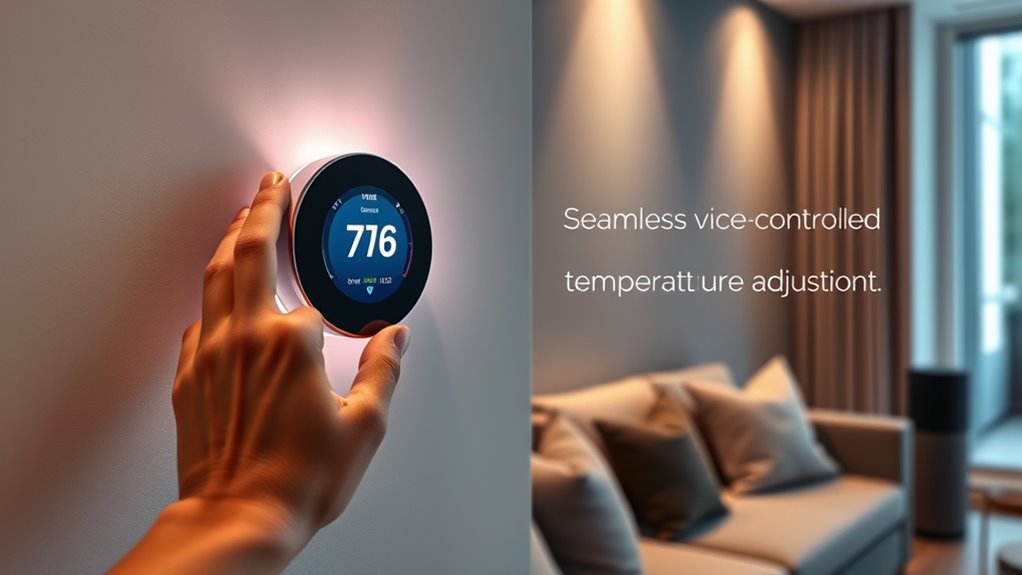
Configuring voice commands for temperature adjustments allows you to control your smart thermostat quickly and effortlessly. To customize your voice command setup, access the voice command customization options in your app or voice assistant settings. Here, you can assign specific phrases like “Set the temperature to 72 degrees” or “Make it warmer” for easy control. Be sure to review your privacy settings to manage data sharing and guarantee your personal information remains protected. Adjust these privacy settings according to your comfort level, so your voice commands are secure and private. Once configured, you can confidently adjust your thermostat with simple voice commands, enhancing convenience and comfort in your space. Proper setup of voice command customization and privacy settings ensures seamless and secure control over your home’s temperature. Additionally, understanding voiceover script optimization can help you deliver clearer and more impactful commands during your interactions. Being aware of the operating hours of your local stores can also help you plan your visits more efficiently, avoiding long waits and ensuring product availability.
Troubleshooting Common Connectivity Issues
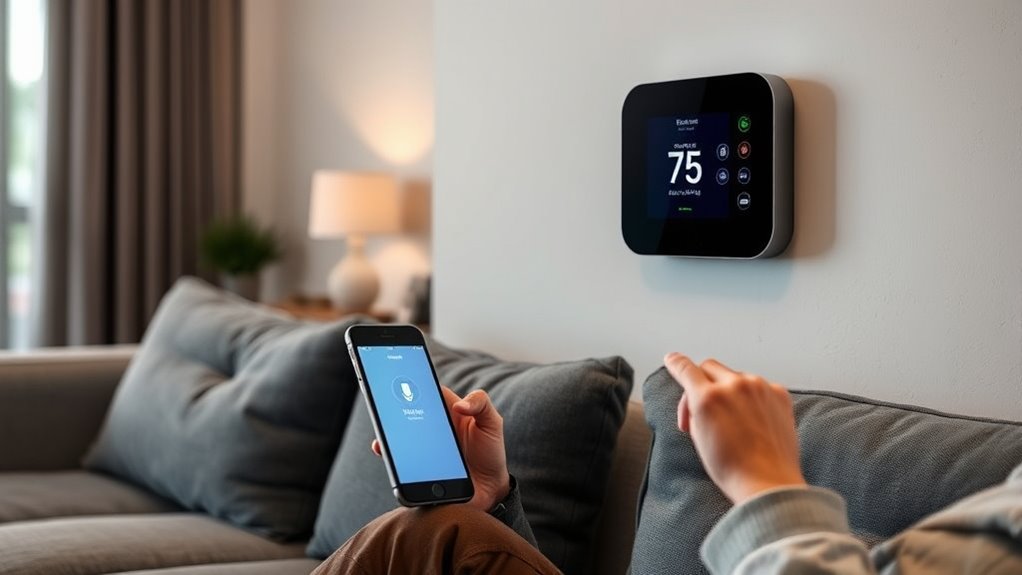
Even with your voice commands set up properly, connectivity issues can hinder your ability to control your smart thermostat easily. If your device isn’t responding, start by remote troubleshooting: check your Wi-Fi connection and make certain your thermostat is within range. Restart your router and reconnect the device if needed. Firmware updates are also vital; outdated software can cause communication problems. Regularly check for updates through the thermostat’s app or settings menu and install them promptly. If issues persist, reset your device or re-pair it with your Wi-Fi network. Remember, maintaining a strong, stable internet connection and keeping your firmware current are key to seamless voice control. Troubleshooting these common connectivity problems ensures you can manage your thermostat effortlessly. Additionally, understanding best practices for Wi-Fi setup can help prevent future issues and improve overall device responsiveness. Ensuring your Wi-Fi network is optimized can also reduce interference from other devices, which may disrupt your connection.
Tips for Maximizing Voice Control Efficiency
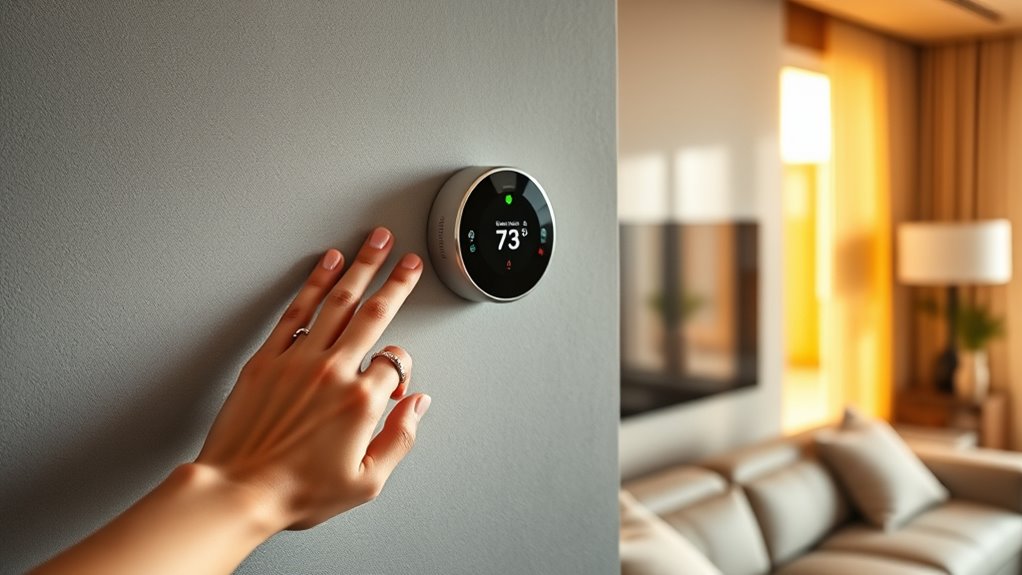
To maximize your voice control efficiency, it’s vital to speak clearly and directly when issuing commands. This helps guarantee your smart thermostat understands you accurately, leading to better energy savings and consistent comfort. Use specific phrases and avoid background noise that can interfere with recognition. Regularly update your device’s software to improve responsiveness and security, protecting user privacy. Make sure your voice commands are simple and consistent, avoiding slang or ambiguous phrases. Training your voice recognition system can also enhance accuracy over time. Additionally, familiarize yourself with privacy settings to control what data is shared and stored, maintaining user privacy. Understanding your privacy and cookie preferences can further enhance your control over shared data and device security. Being aware of support hours for your device can help you troubleshoot issues more efficiently when needed. Ensuring your voice recognition system is properly calibrated will improve command accuracy and overall experience. Clear communication and proper setup will make voice control more effective, saving energy and keeping your data safe.
Frequently Asked Questions
Can I Control Multiple Thermostats With One Voice Command?
You can control multiple thermostats with one voice command if your system supports multi-zone control. To do this, you need a proper voice command setup that recognizes specific zones or rooms. Many smart home platforms allow you to group thermostats and issue commands like “Set all thermostats to 72 degrees,” making it easy to manage your home’s climate effectively. Just make sure your devices are compatible and properly configured.
Is Voice Control Compatible With All Smart Thermostat Brands?
Imagine a world where every device whispers in harmony; that’s what voice control offers. Not all smart thermostats are created equal, so voice assistant compatibility and smart home integration vary. Some brands seamlessly connect with popular voice assistants, while others don’t. Before choosing, check if your thermostat supports your preferred voice platform, ensuring effortless, hands-free climate control across your smart home ecosystem.
How Secure Is Voice-Controlled Access to My Thermostat?
Voice-controlled access to your thermostat offers convenience, but it does raise privacy concerns and hacking risks. You should be aware that hackers could potentially access your device if security isn’t strong enough. To protect yourself, use strong, unique passwords, enable two-factor authentication, and keep your device’s firmware updated. Regularly review privacy settings and be cautious about sharing voice commands to minimize risks and keep your smart home secure.
Can I Set Specific Schedules Using Voice Commands?
Voice command limitations can make scheduling via voice tricky, but many smart thermostats now let you set specific schedules with simple voice commands. You can tell your device to change the temperature at certain times or days, and it’ll adjust accordingly. Keep in mind, though, some models might have restrictions, so check your thermostat’s capabilities. Overall, voice control makes managing your schedule more convenient and hands-free.
What Voice Commands Work Best for Energy Savings?
Think of your voice as the magic wand of energy savings. To maximize efficiency, use voice command customization by asking your smart thermostat to “lower the temperature at night” or “set energy-efficient routines.” These commands help reduce energy consumption without sacrificing comfort. Clear, specific instructions guarantee your device responds accurately, turning your voice into a powerful tool for savings. Harness this magic to keep your home cozy and bills low.
Conclusion
Now that you’ve set up and linked your smart thermostat with your voice assistant, controlling your home’s temperature becomes a breeze. Just remember, Rome wasn’t built in a day—be patient as you fine-tune your commands and troubleshoot issues. With a little practice, you’ll find that voice control can truly make your life easier and more comfortable. Keep at it, and soon you’ll be speaking to your thermostat like a pro.
